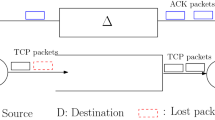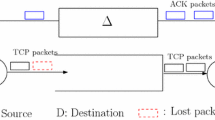Abstract
Recently, several researchers have developed equations for modeling TCP behaviors, such as the expected throughput or latency, based on Markov chains derived from TCP with additional simplifying assumptions. In this paper, we suggest new directions for Markov chain analyses of TCP. Our first contribution is to closely examine not just the expectation but the entire cumulative distribution function of transfer times under various models. Particularly for short or medium transfers, the distribution is likely to be more useful than the expectation in terms of measuring end-user satisfaction. We find that the shapes of TCP cumulative distribution functions are remarkably robust to small changes in the model. Our results suggest that simplifying Markov analyses can be extended to yield approximations for the entire distribution as well as for the expectation.
Our second contribution is to consider correction procedures to enhance these models. A correction procedure is a rule of thumb that allows equations from one model to be used in other situations. As an example, several analyses use a Drop-Tail loss model. We determine correction procedures for the deviation between this model and other natural loss models based on simulations. The existence of a simple correction procedure in this instance suggests that the high-level behavior of TCP is robust against changes in the loss model.
Similar content being viewed by others
References
M. Allman, V. Paxson, and W. Stevens. TCP congestion control. IETF RFC2581, 1999.
E. Altman, K. Avrachenkov, and C. Barakat. A stochastic model of TCP/IP with stationary random losses. In Proceedings of SIGCOMM, pp. 231-242, 2000.
P. Barford and M. Crovella. Critical path analysis of TCP transactions. In Proceedings of SIGCOMM 2000, pp. 127-138, 2000.
J. Bolot and A. Vega-Garcia. Control mechanisms for packet audio in the internet. In Proceedings of IEEE Infocom'96, pp. 232-239, 1996.
J.-C. Bolot. Characterizing end-to-end packet delay and loss in the internet. Journal of High-Speed Networks, 2:305-323, 1993.
J. Byers, M. Frumin, G. Horn, M. Luby, M. Mitzenmacher, A. Roetter, and W. Shaver. FLID-DL: congestion control for layered multicast. In International Workshop on Networked Group Communication, pp. 71-81, 2000.
N. Cardwell, S. Savage, and T. Anderson. Modeling TCP latency. In Proceedings of IEEE Infocom'00, 2000.
Y. Chen and G. Lindsay. How to lose a customer in a matter of seconds. Fortune, 1, 2000. At www.fortune.com/fortune/technology/2000/06/12/ega.html.
D. Chiu and R. Jain. Analysis of the increase/decrease algorithms for congestion avoidance in computer networks. Journal of Computer Networks and ISDN, 17:1-14, 1989.
K. Fall and S. Floyd. Simulation-based comparisons of Tahoe, Reno, and SACK TCP'. Computer Communication Review 26:5-21, 1996.
S. Floyd, M. Handley, J. Padhye, and J. Widmer. Equation-based congestion control for unicast applications. In Proceedings of ACM SIGCOMM 2000, pp. 43-56, 2000.
S. Floyd and V. Jacobson. Random early detection gateways for congestion avoidance. IEEE Network, 1: 397-413, 1993.
J. Hoe. Start-up dynamics of TCP's congestion control and avoidance schemes. Master's thesis, MIT, 1995.
V. Jacobson. Congestion avoidance and control. In Proceedings of SIGCOMM'88, pp. 314-329, 1988.
J. Mahdavi and S. Floyd. TCP-friendly unicast rate-based flow control. Manuscript, 1997. URL http://www.psc.edu/networking/papers/tcp_friendly.html.
M. Mathis, J. Semske, J. Mahdavi, and T. Ott. The macroscopic behavior of the TCPcongestion avoidance algorithm. Computer Communication Review, 27:67-82, 1997.
T. Mendez. Detection of pathological TCP connections using a segment trace filter. Computer Communication Review, 22:28-35, 1992.
V. Misra, W. Gong, and D. Towsley. Stochastic differential equation modeling and analysis of TCP windowsize behavior. In Proceedings of Performance'99, Appears as Technical Report ECE-TR-CCS-99-10-01, 1999.
J. Mogul. Observing TCP dynamics in real networks. In Proceedings of SIGCOMM'92, pp. 305-317, 1992.
J. Padhye, V. Firoiu, and D. Towsley. A stochastic model of TCP Reno-congestion avoidance and control, Technical report 99-02, Department of Computer Science, University of Massachusetts at Amherst, 1999.
J. Padhye, V. Firoiu, D. Towsley, and J. Kurose. Modeling TCP throughput: a simple model and its empirical validation. IEEE/ACM Transactions on Networking, 8:133-145, 2000.
V. Paxson. Automated packet trace analysis of TCP implementations. In Proceedings of SIGCOMM' 97, pp. 167-179, 1997.
V. Paxson. End-to-end Internet packet dynamics. IEEE/ACM Transactions on Networking, 7:277-292, 1999.
B. Sikdar, S. Kalyanraman, and K. Vastola. An integrated model for the latency and steady state throughput of TCP connections. In Proceedings of IFIP Symposium on Advanced Performance Modeling, 2000.
K. Thompson, G. J. Miller, and R. Wilder. Wide-area Internet traf.c patterns and characteristics IEEE Network, 11:10-23, 1997.
UCB/LBNL/VINT. Network simulator ns-2, Simulation software, 1998.
G. R. Wright and W. R. Stevens. TCP/IP Illustrated Vol. 2: The Implementation. Addison-Wesley, Reading, Mass., 1995.
M. Yajnik, S. B. Moon, J. Kurose, and D. Towsley. Measurement and modeling of the temporal dependence in packet loss. In Proceedings of IEEE Infocom'99, pp. 345-352, 1999.
L. Zhang, S. Shenker, and D. Clark. Observations on the dynamics of a congestion control algorithm: the effects of two-way traffic. In Proceedings of SIGCOMM'91, pp. 133-147, 1991.
Y. Zhang, V. Paxson, and S. Shenker. The stationarity of Internet path properties. Technical report, AT&T Center for Internet Research at ICSI, 2000.
R. Zorzi, A. Chockalingam, and R. Rao. Throughput analysis of TCPon channels with memory. IEEE Journal on Selected Areas in Communications, 18:1289-1300, 2000.
Author information
Authors and Affiliations
Rights and permissions
About this article
Cite this article
Mitzenmacher, M., Rajaraman, R. Towards More Complete Models of TCP Latency and Throughput. The Journal of Supercomputing 20, 137–160 (2001). https://doi.org/10.1023/A:1011126701791
Issue Date:
DOI: https://doi.org/10.1023/A:1011126701791




